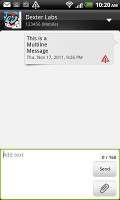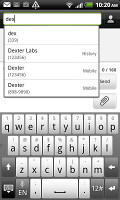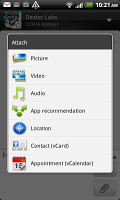Introduction
They say music soothes even the savage beast. In the case of the HTC Sensation XL, it just makes it cooler. The Sensation XL shares its design and mammoth 4.7" screen with the Titan, but the XL is part of the Android squad and packs a lyrical iBeats headset.
The Sensation XL uses almost exactly the same hardware as the Titan - the major difference is that the XL packs four Android capacitive keys and there's no hardware shutter key, but that's about it.
The single Scorpion core in the Snapdragon chipset runs at 1.5GHz again and the camera is an 8MP unit that records 720p video. Even the screen is the same 4.7" WVGA S-LCD unit, not the qHD resolution of the Sensation XE.
Here's the list of pros and cons to sum up how well the merging of Titan hardware and Sensation software went.
Key features
- Quad-band GSM and dual-band 3G support
- 14.4 Mbps HSDPA and 5.76 Mbps HSUPA
- 4.7" 16M-color capacitive S-LCD touchscreen of WVGA resolution (480 x 800 pixels)
- Android OS v2.3 Gingerbread with HTC Sense 3.5
- 1.5 GHz single Scorpion CPUs, Adreno 205 GPU, Qualcomm Snapdragon MSM8255 chipset
- 768 MB RAM; 16 GB storage (~12.5GB user accessible)
- Beats audio enhancement and premium Monster iBeats headset
- 8 MP autofocus camera with dual-LED flash; face detection, geotagging, HDR mode, image autoupload
- 720p video recording @ 30fps, slo-mo videos (2x at WVGA)
- Wi-Fi b/g/n and DLNA
- GPS with A-GPS
- Stereo FM radio with RDS
- Accelerometer, proximity and ambient light sensor
- Front facing camera with video calls
- Standard 3.5 mm audio jack
- microUSB port (charging) and stereo Bluetooth v3.0
- Smart dialing, voice dialing
- Office document editor
- DivX/XviD video support
- HTC Locations app
- HTCSense.com integration
- HTC Portable Hotspot
- Ultra-fast boot times (if you don’t remove battery)
Main disadvantages
- WVGA resolution is low for a 4.7" screen
- Screen's outdoor performance isn't so good
- No dedicated camera key
- No microSD card slot
- No TV-Out
One major addition to the Sensation XL that the Titan lacks is the Beats setup. It includes a Monster iBeats headset in the box (those are rather pricy if you have to buy them separately) and special audio processing done on the inside tuned by none other than Dr. Dre.
Compared to the other Androids by HTC (or in fact most other phones), the bigger screen of the XL is more accommodating to web browsing, watching videos and reading ebooks. The more screen real estate should be better for games too - if the Adreno 205 GPU is up to it (it's getting old, but should still be OK with most games).
Well, time to pull out the lauded iBeats headset out of the box and give them a listen while we tour the hardware of the HTC Sensation XL.
Design and build quality
HTC have kept the design of the Sensation XL very clean. There are no different materials patched up together like on some other phones (*cough*Sensation*cough*). We especially like the big aluminum plate of the back that wraps around the sides too - it gives the phone a really premium feel.
When you put it next to phones with 4.3" screens, the HTC Sensation XL is noticeably bigger, but not huge. It's still phone-sized compared to 5+ inch phoneblets.
The S-LCD capacitive unit of the HTC Sensation XL has WVGA resolution and not qHD, which has been a common sight of late in HTC phones. It was obviously not an option for the Titan (WP7 supports only WVGA for now) but Android scales happily to higher resolutions (720p resolution would have been amazing on the XL's screen).
To put things into perspective, the HTC Sensation XE's 4.3" touchscreen has a pixel density of 256ppi, while the XL manages only 199ppi.
Yes, the screen size is quite a stretch for the resolution. This is most embarrassingly visible when reading text (e.g. in the web browser). Text is as good as impossible to read at max zoom-out - you need to zoom in, but that means you lose some of the real-estate advantage that the large screen gives you.
Resolution aside, the screen is one of the best we've seen by HTC - it has brilliant viewing angles (there's some minor contrast loss, but that's it) and colors are very vivid.
We measured the brightness and contrast of the Sensation XL's screen and (expectedly) it turned out very close to that of the Titan. The display is pretty bright though the black levels could be better. Contrast stays above 1000:1, which is pretty good, better than the Sensation XE.
| Display test | 50% brightness | 100% brightness | ||||
| Black, cd/m2 | White, cd/m2 | Black, cd/m2 | White, cd/m2 | |||
| HTC Sensation XL | 0.22 | 231 | 1045 | 0.52 | 559 | 1085 |
| HTC Titan | 0.26 | 233 | 891 | 0.56 | 567 | 1007 |
| HTC Sensation | 0.21 | 173 | 809 | 0.61 | 438 | 720 |
| Motorola Atrix 4G | 0.48 | 314 | 652 | 0.60 | 598 | 991 |
| LG Optimus 2X | 0.23 | 228 | 982 | 0.35 | 347 | 1001 |
| Sony Ericsson XPERIA Arc | 0.03 | 34 | 1078 | 0.33 | 394 | 1207 |
| Samsung I9100 Galaxy S II | 0 | 231 | ∞ | 0 | 362 | ∞ |
| HTC Incredible S | 0.18 | 162 | 908 | 0.31 | 275 | 880 |
| Apple iPhone 4 | 0.14 | 189 | 1341 | 0.39 | 483 | 1242 |
The display coating is highly reflective though, which ruins sunlight legibility - the reflections of the sky often eclipse the screen contents.
Above the HTC Sensation XL's screen there's a secondary 1.3 MP video-call camera, a proximity sensor and an ambient light sensor. There's a charging/notification LED there too that remains invisible when it's off.
Four haptic-enabled capacitive touch controls are placed below the 4.7"display. The usual Android keys (Home, Menu, Back and Search) are well-spaced and easy to use.
The sides of the Sensation XL are light on ports and buttons - the left side houses an exposed microUSB port, which doubles as a charging port. The right side has only the big volume control, which isn't the most comfortable volume rocker we've used.
The top of the HTC Sensation XL features the 3.5 mm audio jack, a secondary microphone for active noise cancellation and the power/lock button. The power/lock button is flush with the surface to prevent accidental presses but is relatively easy to use - but you have to use two hands, the phone is just too big to reach the button with one hand.
At the bottom of the XL is the primary microphone and the battery cover latch.
Over at the back, the 8MP camera lens sits between a dual LED flash combo and a loudspeaker grill. The camera protrudes so the phone rests on it when you place it down. You need to be careful what surfaces you put it on or the lens might get scratched.
Pressing the battery cover latch causes the screen and phone innards to pop out. Effectively, the battery cover wraps the phone's body in. This solution helps avoid wobbles and squeaks but doesn't quite qualify as a unibody. We have a full-sized battery cover and a phone that divides into two equally sized parts. For a real unibody, you need to check out the HTC Radar or the older HTC Legend.
Still, the back cover is made almost entirely of aluminum and quite a thick piece of it too - you can see "ribs" on the side of the cover to ensure there isn't even a millimeter of the back that gives way when you press it.
There's a patch of plastic at the bottom, which houses the wireless antennas. The antennas are well isolated and don't suffer from the death grip. The only downside of this solution is that all wireless signals are cut off when you take the back cover off.
Anyway, underneath you'll find a 1600 Li-Ion battery and the SIM card compartment. There's no microSD card slot here.
The battery could have been bigger, for reference the Sensation XE packs a 1730mAh battery (though it needs it to feed its dual-core CPU).
We performed a detailed battery test on the HTC Sensation XL and it lasted 40 hours when subjected to general usage. The battery lived long in 3G calls - 9 hours and 30 minutes, longer than the advertised 6 hours and 50 minutes. The Sensation XL lasts 5 hours and 20 minutes of web browsing over Wi-Fi and 6 hours and 10 minutes of video watching.
Those numbers compare favorably against the competition, except the video playing performance, which is 2-3 hours behind the leaders of the pack.
The HTC Sensation XL fits well in the hand in most pockets. Still, the sizable screen means you'll have trouble reaching the top items on the display, at least at first. You get used to it but still isn't the most comfortable thing in the world.
This aside, the build quality of the XL is great - the large slab of aluminum on the back gives the phone a premium feel and even the white plastic for the antennas is great. The phone is a bit on the heavy side, but it's not too much of a burden.
The processor core for an extra 0.4" of screen - is the tradeoff from the Sensation XE worth it? We already saw how the 4.7" screen performs, later we'll be running benchmarks to gauge the performance difference.
But first we'll do the overview of the latest Sense UI, which while familiar, packs a few changes since we last saw it.
Updated phonebook
The Sensation XL has HTC’s all-knowing phonebook with deep social networking integration. It manages to keep things neatly in order, even though it’s juggling everything from SMS to Facebook photo albums.
The entire People app (the phonebook) is tabbed and with more tabs than the stock Android. Version 3.5 of Sense merges the Phone and People apps into one. So, you have the dialer, all contacts, groups (including favorite contacts there), as well as a call log.
From a drop-down menu at the top, you can filter contacts based on where they came from - the phone's address book, Facebook, Twitter or your HTC Sense account.
One thing we liked about the phonebook is that it makes good use of the big screen. The list of contacts has two lines per entry, the contact's name and their latest SNS update (with an icon to identify the social network used).
As usual, selecting a contact displays the basic details: name and photo, numbers, emails and such. The interface is tabbed here but it has been reorganized and the new view makes more sense (if you'll pardon the pun).
The second tab is called Thread - it lists regular messages, email and call history with that contact. It's the next tab, Updates, that handles the social networking side of things - it lists both events with that contact from online calendars and also SNS status update.
The fourth final tab holds the online galleries of the contact, including Facebook and Flickr.
When editing a contact, you start off with just one of the essential fields but you can easily add more.
If you’re switching from another phone don’t worry – you don’t even need a computer to pull your contacts, messages and calendar items from the old phone into your new Sensation XL. The Transfer app supports many phones from major manufacturers and moves the data over Bluetooth.
It’s an old trick (Symbian-powered Nokias have been doing this for ever) and most people would probably go with syncing the contacts over the cloud, but still it’s a handy tool to have.
Smart and voice dialing
We had no issues with reception and in-call audio quality with the HTC Sensation XL.
The on-screen dialer features a keypad, a shortcut to the call log and a list of contacts beneath (you can hide the keypad). The HTC Sensation XL has both Smart Dialing and Voice dialing.
The Sensation XL knows some accelerometer-based tricks – turning the phone over will mute the ringer of an incoming call while placing it down starts the loudspeaker automatically when you are in the middle of a call. The other feature is Quiet ring on pickup – once you move the phone, the ringer will quiet down (but not cancel the call).
Yet another option is pocket mode – the ringer volume will increase if the phone is in your pocket (the proximity sensor takes care of detecting that).
Here's how the HTC Sensation XL fares in our traditional loudspeaker performance test. It scored an Average mark putting it somewhere in the middle among its competitors. The Titan had a different, wider loudspeaker grill and performed much better than the Sensation XL.
| Speakerphone test | Voice, dB | Ringing | Overall score | |
| Samsung I9000 Galaxy S | 66.6 | 65.9 | 66.6 | |
| Samsung Galaxy Note N7000 | 62.9 | 61.7 | 68.0 | |
| HTC Sensation XL | 70.7 | 61.5 | 70.7 | Average |
| HTC Sensation XE | 65.8 | 65.4 | 76.9 | Good |
| Samsung I9100 Galaxy S II | 70.0 | 66.6 | 75.7 | Good |
| HTC Titan | 75.8 | 66.2 | 82.7 | Very Good |
| HTC Gratia | 73.2 | 73.6 | 83.5 | Excellent |
Text messaging does it all
Android and the HTC Sensation XL are capable of handling all sorts of text messaging – SMS, MMS, email. Social networking is covered by several apps and widgets, and there’s Gtalk, which can connect you to Google’s chat network and compatible networks too (like Ovi Chat).
The notification area will display a line of an incoming SMS or just the number of messages if there’s more than one. You can set the status LED to alert of unread messages too.
SMS and MMS messages are displayed in threads – you see a list of all conversations, each one is listed with the contact’s photo, name and the subject of the last message, as well as a part of the actual message (you can set the preview to be one, two or three lines). Tapping a conversation brings up the entire message history with that contact.
The whole thing looks almost the same as a chat client. When viewing a thread, the most recent message is placed at the bottom.
To add recipients, just start typing a name or number and choose from the contacts offered – the phone will find the contact you want even if you misspell it (e.g. “drx” matches Dexter).
Converting SMS into MMS is as simple as adding some multimedia content to the message. You can just add a photo or an audio file to go with the text, or you can get creative with several slides and photos.




All threads • viewing a specific thread • Adding recipients • Attaching a multimedia file turns the SMS to MMS
You can enabled delivery notifications and you can backup text messages to the internal storage memory (and restore them from there later).
Text input on the Sensation XL boils down to an on-screen custom-made HTC virtual QWERTY keyboard. While it’s still not as good as a hardware one, it’s the next best thing – the 4.7” screen has enough real estate for big, well-spaced keys, which are easy to hit.
The compose text box is big and covers over half of the screen in landscape mode. A tap-and-hold on the text box gives you access to functions such as cut, copy and paste. You are free to paste the copied text across applications like email, notes, chats, etc. and vice versa.
Gingerbread text selection is very user friendly. Upon a press and hold, a “magnifying glass” appears, enabling accurate cursor movements.
HTC Mail app almost as good as Gmail
The HTC Sensation XL comes with two email apps – the traditional Gmail app and the generic HTC Mail app, which merges all your email accounts into a single inbox.
The Gmail app has the trademark conversation style view and can manage multiple (Gmail) accounts. Batch operations are supported too, in case you need to handle email messages in bulk.
The standard HTC Mail app has been updated too. Emails are organized into three tabs and can be sorted by date, sender, subject, priority or size (both ascending and descending). You can browse all folders for the email account or view all inboxes combined.
If you go for the latter option, emails are color-coded so it's easy to tell which email belongs to which account. You can mass delete emails or mark them as read too (you can't perform other operations en masse like you can in Gmail though).
Back to the tabs. The first one, Received, contains all the emails. Then comes the Thread tab - it groups related emails into conversations (hit the down arrow to see the list), but once you open an email you can only view them one at a time.
There are previous/next buttons in the menu, but it would have been more convenient to view all messages together on the screen (like in the Gmail app).
Anyway, you have a Favorites tab that holds only email from contacts in the Favorites group and an Invite tab that collect invitations from online calendars.
There's hardly anything the HTC Sensation XL lacks in terms of email capabilities. The settings for popular email services are automatically configured. POP/IMAP accounts and Active Sync accounts are supported.
The 8MP camera is better than Titan's
The HTC Sensation XL packs an 8MP camera that does stills of up to 3264x2448 pixels and records 720p video @ 30fps. There’s a dual-LED flash / video light too.
The camera interface is very space efficient - even more so after the Sense 3.5 update. Most of the controls are on the right side of the viewfinder, with the virtual shutter in the center. The still/video toggle and front/back camera toggles have been combined in a single menu and the Effects button has been moved to the top left corner - this freed up space for the Scenes and Settings button.
There’s a gallery shortcut (a thumbnail of the last photo taken) in the bottom left corner and a virtual zoom lever along the bottom. By default the viewfinder image is cropped so that it fills the entire screen, but you can switch that off (note that cropping reduces the resolution).
Final words
It's certainly nice to be able to choose between platforms. But while there aren't that many handsets to choose from in WP7 land, Androids come in all shapes and sizes.
Not that the HTC Sensation XL isn't pretty unique. With a massive 4.7" screen and solid aluminum build, not to mention the smooth running Sense UI, the XL can scratch your tablet itch. And your itch for a better portable MP3 player too.
It's not tablet-sized, but unlike actual tablets, there’s always room in a pocket for the Sensation XL. And that screen is big enough for tasks like web browsing (the browser performance impressed us too) and reading texts.
The processor behaved admirably on most counts but the Adreno 205 GPU was a disappointment. The limited storage also might put a crimp in your movie watching (16GB still fits enough DVD-quality movies though and you have the option of using of HTC Watch).
The camera of the Sensation XL surprised us pleasantly though, by beating its Titan twin.
But sometimes a big screen is what you want and you're willing to turn a blind eye to the drawbacks. Here are some alternatives that offer a big screen too, plus a little extra.
The HTC Titan is the obvious alternative - it's more or less the same phone, but with the exciting Windows Phone Mango OS. It has most of the same weaknesses as the Sensation XL though and Windows Phone isn't as customizable as Android.
Then there's the Samsung Galaxy Nexus - 4.65" of 720p SuperAMOLED goodness are hard to resist. You also get more processing power (1.2GHz dual-core CPU, better graphics), it comes in 16/32GB options (memory not expandable) and you do get the latest version of Android - plus a promise for quick updates to the next releases.
The HTC Raider 4G has a slightly smaller screen - 4.5" - but it is qHD and you get a more powerful chipset (dual core, 1GB RAM), expandable memory, and MHL TV-Out. And let's not forget the LTE connectivity.
No comments:
Post a Comment